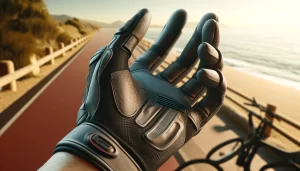Cycling glasses are more than just a fashion statement—they are a critical component of any cyclist’s gear. Whether you’re sprinting down city streets or cruising on mountain trails, the right pair of glasses can drastically improve your riding experience.
They not only protect your eyes from harmful UV rays but also shield them from wind, dust, and debris that could impede your vision. This protection is paramount, as clear vision is crucial for both safety and performance when cycling.
Understanding the importance of cycling glasses can be a game changer for any rider. These specialized eyewears are designed with features that enhance visibility and comfort under various environmental conditions.
By investing in a quality pair, you equip yourself with a tool that not only guards against potential eye injuries but also enhances your ability to see subtle changes in the terrain. Keep reading to discover how these glasses can transform your cycling experience, making every ride safer and more enjoyable.

Image Source: Image Generated With DALL-E on ChatGPT
Benefits of Cycling Glasses for Eye Protection
Cycling glasses are essential for riders not only to enhance vision but also to provide critical eye protection. Designed to shield eyes from UV rays, they prevent long-term damage like cataracts and macular degeneration.
Additionally, these glasses are built to resist the impact of road debris and insects, thus preventing injuries and distractions. Their wraparound design also offers protection against wind and dust, reducing eye dryness and irritation. This makes cycling glasses indispensable for both safety and comfort during rides, regardless of the weather conditions.
Steps to Maximize Eye Protection with Cycling Glasses:
- Choose UV Protection: Ensure the glasses offer 100% UV protection.
- Select Impact-Resistant Lenses: Opt for polycarbonate lenses for high impact resistance.
- Look for Wraparound Styles: These provide better coverage against wind and dust.
- Consider Lens Tint: Different tints can enhance contrast and visibility depending on the lighting conditions.
- Regular Cleaning: Keep the lenses clean to maintain clear vision and prevent scratches.
How to Choose the Perfect Fit in Cycling Glasses
Selecting the perfect fit for cycling glasses is crucial for comfort and effectiveness. Glasses that fit well stay in place during vigorous movements and provide optimal protection and visibility. To ensure a snug fit, the glasses should not pinch at the temples or press on the nose.
Adjustable features such as nose pads and temple tips can help achieve a customized fit. Additionally, the weight of the glasses should be distributed evenly to avoid pressure points. A good fit also ensures that the frame does not obstruct peripheral vision, thereby enhancing safety and performance on the bike.
Tips for Selecting the Perfect Fit in Cycling Glasses:
- Check the Nose Bridge Fit: Glasses should not slide down; adjustable nose pads can help.
- Evaluate Temple Length and Fit: Temples should extend straight back without pressing into the side of your head.
- Consider Weight Distribution: Well-balanced glasses reduce discomfort and improve stability.
- Assess Coverage: Ensure that the frame’s edges do not block peripheral vision.
- Try Before You Buy: Whenever possible, test different styles to see what feels best during actual movement.
Types of Lenses for Cycling Glasses
Cycling glasses come equipped with various types of lenses to cater to different cycling conditions and preferences. Clear lenses are ideal for protection without altering light conditions, making them suitable for evening or low-light rides. Yellow or orange lenses enhance contrast and depth perception in overcast or similar low-light scenarios.
Grey lenses are perfect for reducing glare in bright sunlight without distorting colors. Polarized lenses cut glare from reflective surfaces, making them ideal for cyclists frequently encountering wet roads or bodies of water. Photochromic lenses adjust their tint based on light conditions, providing versatility across different times of the day.
Steps to Choose the Right Lens Type for Cycling Glasses:
- Assess Your Typical Riding Conditions: Choose lens colors and features based on your most frequent cycling environments.
- Prioritize Glare Reduction: Consider polarized lenses if you ride in bright, reflective conditions.
- Opt for Versatility: Photochromic lenses are beneficial for riders who experience varying light conditions.
- Enhance Visibility: Use tinted lenses like yellow for low light to improve visual clarity.
- Test Different Tints: Experience how different tints affect your visibility and comfort in usual riding conditions.
Cycling Glasses for Varied Weather Conditions
Cycling glasses designed for varied weather conditions are essential for cyclists who face changing environments. These glasses typically feature interchangeable lenses to quickly adapt to different lighting and weather scenarios.
For bright sunny days, dark tinted lenses are necessary to reduce eye strain. In contrast, clear or light yellow lenses are preferable for cloudy or rainy conditions to improve visibility. Some glasses also come with anti-fog coatings to prevent vision obstruction in humid or cold conditions. This adaptability ensures that cyclists can maintain optimal vision and eye protection regardless of weather changes.
Tips for Using Cycling Glasses in Varied Weather Conditions:
- Invest in Interchangeable Lenses: This allows for quick adjustments to match the current weather conditions.
- Apply Anti-Fog Spray: To prevent lens fogging during transitions between hot and cold environments.
- Use Hydrophobic Coating: This helps repel water in rainy conditions, keeping vision clear.
- Carry Spare Lenses: Always have alternative lenses on hand for unexpected weather changes.
- Choose Durable Frames: Ensure that the frames can withstand frequent lens changes and diverse weather conditions.
Maintenance and Care for Cycling Glasses
Proper maintenance and care of cycling glasses are crucial to prolonging their lifespan and ensuring they provide maximum protection and visibility. It starts with regular cleaning, which involves gently washing the lenses with mild soap and water to remove dirt, sweat, and oils that can accumulate during rides.
It’s important to avoid using abrasive materials or harsh cleaners that can scratch or degrade the lens coating. After washing, lenses should be dried with a soft, lint-free cloth. Storing the glasses in a hard-case when not in use prevents accidental scratches or damage, particularly important for maintaining specialized coatings like anti-fog and UV protection.
Additionally, routine checks and adjustments should be part of the care regimen. Screws at the temples and nose bridges can loosen over time, so it’s important to periodically tighten them to ensure the glasses fit securely. Replacing worn-out nose pads and temple grips can also enhance comfort and fit.
For glasses with interchangeable lenses, care should be taken to avoid touching lenses with dirty fingers during swaps, as this can leave smudges and potentially scratch the lenses. By adhering to these care practices, cyclists can maintain the optimal performance of their eyewear, ensuring clarity of vision and eye safety during every ride.

Image Source: Image Generated With DALL-E on ChatGPT
How Cycling Glasses Can Enhance Performance
Cycling glasses are not merely for eye protection; they significantly enhance athletic performance by improving vision clarity and reducing distractions. By shielding the eyes from UV rays, cyclists experience less eye fatigue, which is crucial during long rides under the sun. Moreover, the right lens tint can improve contrast and depth perception, allowing cyclists to see more details of the road or trail ahead. T
his can lead to faster reaction times and better decision-making, particularly important in competitive cycling or challenging terrains. Glasses that reduce glare also prevent squinting, which can improve focus and reduce the risk of headaches, contributing to a more comfortable and enduring performance.
In addition to visual benefits, cycling glasses can improve aerodynamics, a subtle but valuable aspect for performance cycling. The streamlined design of modern cycling glasses can reduce drag, especially at high speeds, and the protection they offer against wind and debris allows cyclists to maintain optimal eye health and vision, which are essential for peak performance.
When eyes are unprotected, they can water or become irritated, which can distract from the race or ride. Therefore, investing in a pair of high-quality cycling glasses can be seen as essential equipment for anyone looking to optimize their cycling performance and comfort.
Common Questions About Cycling Glasses
1. Why are cycling glasses necessary?
Cycling glasses protect your eyes from UV rays, wind, debris, and insects, which can be hazardous during a ride. They also enhance visibility under various lighting conditions.
2. What are the best lens colors for cycling glasses?
The choice depends on your typical riding conditions. Grey lenses are great for bright sunlight, yellow or orange enhance contrast in low light, and clear lenses are ideal for night riding.
3. Are expensive cycling glasses worth the investment?
Higher-priced glasses often feature advanced materials and lens technologies that provide better durability, comfort, and optical clarity. They can be a worthwhile investment for frequent cyclists.
4. Can I wear prescription lenses with cycling glasses?
Many cycling glasses are compatible with prescription inserts or can be fitted with prescription lenses, making them suitable for riders who require corrective eyewear.
5. How should I clean and store my cycling glasses?
Clean your glasses with mild soap and water, using a soft cloth to dry them. Always store them in a protective case to prevent scratches and damage.
6. How do I know if my cycling glasses fit properly?
Properly fitting cycling glasses should not pinch your nose or temples, should stay in place during movement, and should not obstruct your peripheral vision.
Cycling glasses are more than just a sporty accessory; they are a crucial element in a cyclist’s gear setup. They provide significant protection and performance enhancements that can make a considerable difference in both casual rides and competitive races.
By addressing common concerns and queries about cycling glasses, cyclists can make informed decisions to select the right eyewear that meets their needs, ensuring safety, comfort, and optimal performance. Understanding the importance of the right fit, lens type, and maintenance can extend the life of the glasses and make cycling a more enjoyable and successful endeavor.
Did you like the article? Be sure to check out more content like this in the Equipment And Accessories category, or see more related content below.






